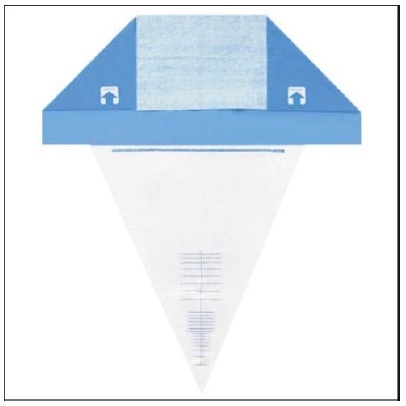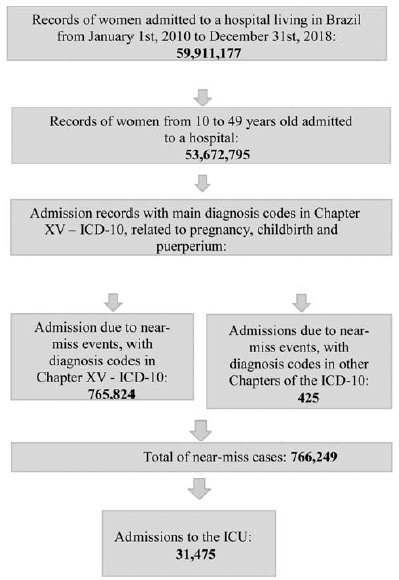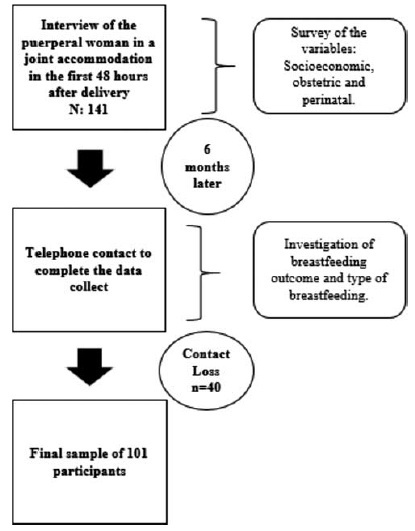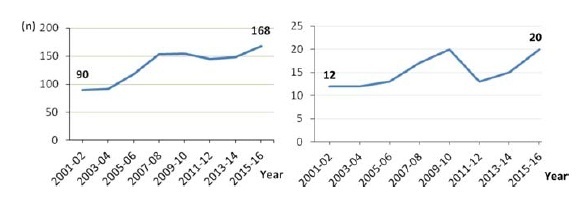Summary
Revista Brasileira de Ginecologia e Obstetrícia. 2021;43(2):113-118
To identify risk factors related to postpartum hemorrhage (PPH) and severe PPH with blood loss quantified objectively.
This is a complementary analysis of a prospective cohort study that included pregnant women delivering vaginally. The total blood loss was obtained through the sum of the volume collected from the drape with the weight of gauzes, compresses and pads used by women within 2 hours. Exploratory data analysis was performed to assess mean, standard deviation (SD), frequency, percentage and percentiles. The risk factors for postpartum bleeding were evaluated using linear and logistic regression.
We included 270 women. Themean blood loss at 120 minutes was 427.49 mL (±335.57 mL). Thirty-one percent (84 women) bled > 500mL and 8.2% (22 women) bled > 1,000 mL within 2 hours. Episiotomy, longer second stage of labor and forceps delivery were related to blood loss > 500mL within 2 hours, in the univariate analysis. In the multivariate analysis, only forceps remained associated with bleeding > 500 mL within 2 hours (odds ratio [OR] = 9.5 [2.85-31.53]). Previous anemia and episiotomy were also related to blood loss > 1,000mL.
Prolonged second stage of labor, forceps and episiotomy are related to increased incidence of PPH, and should be used as an alert for the delivery assistants for early recognition and prompt treatment for PPH.

Summary
Revista Brasileira de Ginecologia e Obstetrícia. 2021;43(3):185-189
The objective of the present study was to analyze the reasons that led to hormone therapies (HTs) regimen changes in women with breast cancer.
This was a retrospective cross-sectional study from a single-institution Brazilian cancer center with patient records diagnosed with breast cancer between January 2012 and January 2017.
From 1,555 women who were in treatment with HT, 213 (13.7%) women had HT switched, either tamoxifen to anastrozole or vice-versa. Most women included in the present study who switched HT were > 50 years old, postmenopausal, Caucasian, and had at least one comorbidity. From the group with therapy change, ‘disease progression’ was reason of change in 124 (58.2%) cases, and in 65 (30.5%) patients, ‘presence of side effects’ was the reason. From those women who suffered with side effects, 24 (36.9%) had comorbidities.
The present study demonstrated a low rate of HT switch of tamoxifen to anastrozole. Among the reasons for changing therapy, the most common was disease progression, which includes cancer recurrence, metastasis or increased tumor. Side effects were second; furthermore, age and comorbidities are risk factors for side effects.
Summary
Revista Brasileira de Ginecologia e Obstetrícia. 2021;43(2):97-106
Cases of maternal near miss are those in which women survive severe maternal complications during pregnancy or the puerperium. This ecological study aimed to identify the temporal trend of near-miss cases in different regions of Brazil between 2010 and 2018, using data fromtheHospital Information System(HIS) of theUnified BrazilianHealth System (SUS, in the Portuguese acronym). Hospital admission records of women between 10 and 49 years old with diagnosis included in the 10th Revision of the International Statistical Classification of Diseases and Related Health Problems (ICD-10) and codes indicating nearmiss events were selected. From 20,891,040 admissions due to obstetric causes, 766,249 (3.66%) near-miss cases were identified, and 31,475 women needed admission to the intensive care unit (ICU). The cases were found to be more predominant in black women over 35 years old from the North and Northeast regions. There was a trend of increase in near-miss rates of ~ 13.5% a year during the period of the study. The trend presented a different behavior depending on the level of development of the region studied. The main causes of near miss were preeclampsia (47%), hemorrhage (24%), and sepsis (18%).

Summary
Revista Brasileira de Ginecologia e Obstetrícia. 2021;43(2):91-96
To analyze the factors associated with the prevalence of exclusive breastfeeding (EBF) for up to six months in mother/infant binomials cared for at a usual-risk maternity hospital.
The present is a descriptive, longitudinal, prospective, quantitative study. Socioeconomic, obstetric and perinatal variables from 101 mother/infant binomials in a Public Maternity Hospital in the city of Curitiba, state of Paraná, Brazil, were investigated during hospitalization after delivery and 6 months after birth. For the statistical analysis, the Chi-squared test was used. The variables that showed values of p < 0.25 for the Chi-squared test were also submitted to an odds ratio (OR) analysis.
The prevalence (42.6%) of EBF was observed. Most women (93.1%) had had more than 6 prenatal consultations, and the variables maternity leave and support to breastfeeding were associated with EBF. Support to breastfeeding by professionals and family members increased 4-fold the chance of maintenance of EBF (OR = 0.232; 95% confidence intercal [95%CI]: 0.079 to 0.679; p = 0.008). Cracked nipples were the biggest obstacle to breastfeeding, and low milk production was the main responsible factor for weaning.
The encouragement of breastfeeding and the mother’s stay for a longer period with the child contributed to the maintenance of EBF until the sixth month of life of the infant.

Summary
Revista Brasileira de Ginecologia e Obstetrícia. 2021;43(2):84-90
To analyze and compare the frequency of cesarean sections and vaginal deliveries through the Robson Classification in pregnant women attended at a tertiary hospital in two different periods.
Cross-sectional, retrospective study of birth records, comprising 4,010 women, conducted from January 2014 to December 2015 in the only public regional referral hospital for the care of high- risk pregnancies, located in Southern Brazil.
The overall cesarean section rate reached 57.5% and the main indication was the existence of a previous uterine cesarean scar. Based on the Robson Classification, groups 5 (26.3%) and 10 (17.4%) were the most frequent ones. In 2015, there was a significant increase in the frequency of groups 1 and 3 (p < 0.001), when compared with the previous year, resulting in an increase in the number of vaginal deliveries (p < 0.0001) and a reduction in cesarean section rates.
The Robson Classification proved to be a useful tool to identify the profile of parturients and the groups with the highest risk of cesarean sections in different periods in the same service. Thus, it allowsmonitoring in a dynamic way the indications and delivery routes and developing actions to reduce cesarean rates according to the characteristics of the pregnant women attended.

Summary
Revista Brasileira de Ginecologia e Obstetrícia. 2021;43(2):137-144
The present study aims to evaluate the profile of endometrial carcinomas and uterine sarcomas attended in a Brazilian cancer center in the period from 2001 to 2016 and to analyze the impact of time elapsed fromsymptoms to diagnoses or treatment in cancer stage and survival.
This observational study with 1,190 cases evaluated the year of diagnosis, age-group, cancer stage and histological type. A subgroup of 185 women with endometrioid histology attended in the period from 2012 to 2017 was selected to assess information about initial symptoms, diagnosticmethods, overall survival, and to evaluate the influence of the time elapsed from symptoms to diagnosis and treatment on staging and survival. The statistics used were descriptive, trend test, and the Kaplan- Meier method, with p-values < 0.05 for significance.
A total of 1,068 (89.7%) carcinomas (77.2% endometrioid and 22.8% nonendometrioid) and 122 (10.3%) sarcomas were analyzed, with an increasing trend in the period (p < 0.05). Histologies of non-endometrioid carcinomas, G3 endometrioid, and carcinosarcomas constituted 30% of the cases. Non-endometrioid carcinomas and sarcomas weremore frequently diagnosed in patients over 70 years of age and those on stage IV (p < 0.05). The endometrioid subgroup with 185 women reported 92% of abnormal uterine bleeding and 43% diagnosis after curettage. The average time elapsed between symptoms to diagnosis was 244 days, and between symptoms to treatment was 376 days, all without association with staging (p = 0.976) and survival (p = 0.160). Only 12% of the patients started treatment up to 60 days after diagnosis.
The number of uterine carcinoma and sarcoma cases increased over the period of 2001 to 2016. Aggressive histology comprised 30% of the patients and, for endometrioid carcinomas, the time elapsed between symptoms and diagnosis or treatment was long, although without association with staging or survival.

Summary
Revista Brasileira de Ginecologia e Obstetrícia. 2021;43(2):131-136
To evaluate whether performing preoperative urodynamic study influences postoperative urinary symptoms of women with stress urinary incontinence that underwent transobturator sling.
Retrospective analysis of patients treated for stress urinary incontinence by transobturator sling from August 2011 to October 2018. Predictor variables included preoperative urodynamic study, age, incontinence severity, body mass index, preoperative storage symptoms and previous anti-urinary incontinence procedure. Outcome variables were postoperative subjective continence status, storage symptoms and complications. Logistic regression after propensity score was employed to compare outcomes between patients who underwent or not pre-operative urodynamic study.
The present study included 88 patients with an average follow-up of 269 days. Most patients (n = 52; 59.1%) described storage symptoms other than stress urinary incontinence, and 38 patients (43.2%) underwent preoperative urodynamic studies. Logistic regression after propensity score did not reveal an association between urinary continence outcomes and performance of preoperative urodynamic study (odds ratio 0.57; confidence interval [CI]: 0.11-2.49). Among women that did not undergo urodynamic study, there was a subjective improvement in urinary incontinence in 92% of the cases versus 87% in those that underwent urodynamic study (p = 0.461). Furthermore, postoperative storage symptoms were similar between women who did not undergo urodynamic study and those who underwent urodynamic study, 13.2% versus 18.4%, respectively (p = 0.753).
Preoperative urodynamic study had no impact on urinary incontinence cure outcomes as well as on urinary storage symptoms after the transobturator sling in women with stress urinary incontinence.
Summary
Revista Brasileira de Ginecologia e Obstetrícia. 2021;43(2):126-130
The present study aimed to assess the effect of Melissa Officinalis L. (a combination of lemon balm with fennel fruit extract) compared with citalopram and placebo on the quality of life of postmenopausal women with sleep disturbance.
The present study is a randomized, double-blind, placebo clinical trial among 60 postmenopausal women with sleep disturbance who were referred to a university hospital from 2017 to 2019. The participants were randomized to receive M. Officinalis L. (500 mg daily), citalopram (30 mg) or placebo once daily for 8 weeks. The Menopause-Specific Quality of Life (MENQOL) questionnaire was self-completed by each participant at baseline and after 8 weeks of the intervention and was compared between groups.
The mean for all MENQOL domain scores were significantly improved in the M. Officinalis L. group compared with citalopram and placebo (p < 0.001). The mean ± standard deviation (SD) after 8 weeks in the M. Officinalis L., citalopram and placebo groups was 2.2 ± 0.84 versus 0.56 ± 0.58 versus 0.36 ± 0.55 in the vasomotor (p < 0.001), 1.02 ± 0.6 versus 0.28 ± 0.2 versus 0.17 ± 0.1 in the psychomotor-social (p < 0.001), 0.76 ± 0.4 versus 0.25 ± 0.1 versus 0.11 ± 0.1 in the physical and 2.3 ± 1.0 versus 0.35 ± 0.5 versus 0.41 ± 0.5 in the sexual domain, respectively.
The results revealed that M. Officinalis L. may be recommended for improving the quality of life of menopausal women with sleep disturbance. Trial registration The present study was registered by the name “Comparison of the efficacy of citalopram and compound of Asperugo procumbens and foeniculum vulgare in treatment of menopausal disorders” with the code in the Iranian Registry of Clinical Trials (IRCT).